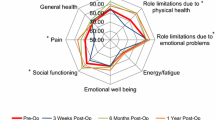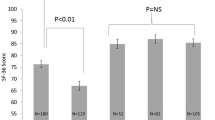Abstract
Purpose
Chronic pain and discomfort are common before and after inguinal hernia repair (IHR) and pain is clearly linked to reduced quality of life (QoL). The long-term effect of IHR on QoL in relation to preoperative symptoms is incompletely described.
Methods
309 men (18–75 years) undergoing IHR under local anesthesia and day care surgery were included. Pre- and postoperative symptoms, pain and QoL (SF-36) were measured before and up to 3 years after surgery.
Results
Before surgery, 197 patients (64%) reported pain (VAS 0.9–5.4) from their inguinal hernia. 102 patients (33%) had other inguinal symptoms, and 26% were asymptomatic. Patients with preoperative groin pain (P) scored their physical QoL (PCS) lower compared with controls (C) (median (IQR) 43.5 (34.7–50.3) vs. 53.9 (47.8–56.9, p < 0.001)), whereas patients with no pain (N) did not (53.0 (47.9–55.9), p = 0.57). Mental QoL was not affected before or after surgery. At 1, 2 and 3 years after surgery, 14, 12 and 7% of patients, respectively, reported groin pain. In P, PCS increased from 43.5 before surgery to 55.3 (p < 0.001) at 36 months, but was unchanged in N (53.0 vs 55.9, p = ns).
Conclusions
The incidence of inguinal pain decreases over time after inguinal hernia repair. Both preoperative reduction and long-term improvement in physical QoL are strongly associated with the presence of preoperative groin pain. This supports, from a QoL perspective, that patients with preoperative pain are those who benefit the most from IHR, also from a long-term perspective.


Similar content being viewed by others
Abbreviations
- QoL:
-
Quality of life
- IHR:
-
Inguinal hernia repair
- LA:
-
Local anesthesia
- SF-36:
-
Short Form 36
- VAS:
-
Visual analogue scale
- PCS:
-
Physical Component Score
- MCS:
-
Mental Component Score
- BMI:
-
Body mass index
- N:
-
Group of patients without preoperative inguinal pain
- P:
-
Group of patients with preoperative inguinal pain
- ES:
-
Effect size
References
Cunningham J, Temple WJ, Mitchell P, Nixon JA, Preshaw RM, Hagen NA (1996) Cooperative hernia study. Pain in the postrepair patient. Ann Surg 224(5):598–602
HerniaSurge Group (2018) International guidelines for groin hernia management. Hernia 22(1):1–165
Magnusson J, Videhult P, Gustafsson U, Nygren J, Thorell A (2014) Relationship between preoperative symptoms and improvement of quality of life in patients undergoing elective inguinal herniorrhaphy. Surgery 155(1):106–113
Magnusson J, Nygren J, Thorell A (2012) Lichtenstein, prolene hernia system, and UltraPro Hernia System for primary inguinal hernia repair: one-year outcome of a prospective randomized controlled trial. Hernia J Hernias Abdom Wall Surg 16(3):277–285
Magnusson J, Nygren J, Gustafsson UO, Thorell A (2016) UltraPro Hernia System, Prolene Hernia System and Lichtenstein for primary inguinal hernia repair: 3-year outcomes of a prospective randomized controlled trial. Hernia J Hernias Abdom Wall Surg 20(5):641–648
Wennstrom I, Berggren P, Akerud L, Jarhult J (2004) Equal results with laparoscopic and Shouldice repairs of primary inguinal hernia in men. Report from a prospective randomised study. Scand J Surg 93(1):34–36
Sullivan MKJ (2002) SF-36 Hälsoenkät: Svensk Manual och Tolkningsguide, 2:a upplagan (Swedish manual and interpretation guide), 2nd edn. Sahlgrenska University Hospital, Gothenburg
Cohen J (1977) Statistical power analysis for the behavioral sciences, Rev. Academic Press, edn. New York
Karlsson J, Taft C, Rydén A, Sjöström L, Sullivan M (2007) Ten-year trends in health-related quality of life after surgical and conventional treatment for severe obesity: the SOS intervention study. Int J Obes (Lond) 31(8):1248–1261
Nienhuijs S, Staal E, Strobbe L, Rosman C, Groenewoud H, Bleichrodt R (2007) Chronic pain after mesh repair of inguinal hernia: a systematic review. Am J Surg 194(3):394–400
Eklund A, Montgomery A, Bergkvist L, Rudberg C (2010) Chronic pain 5 years after randomized comparison of laparoscopic and Lichtenstein inguinal hernia repair. Br J Surg 97(4):600–608
Simons MP, Aufenacker T, Bay-Nielsen M, Bouillot JL, Campanelli G, Conze J, de Lange D, Fortelny R, Heikkinen T, Kingsnorth A et al (2009) European Hernia Society guidelines on the treatment of inguinal hernia in adult patients. Hernia J Hernias Abdom Wall Surg 13(4):343–403
Poobalan AS, Bruce J, Smith WC, King PM, Krukowski ZH, Chambers WA (2003) A review of chronic pain after inguinal herniorrhaphy. Clin J Pain 19(1):48–54
van Hanswijck de Jonge P, Lloyd A, Horsfall L, Tan R, O’Dwyer PJ (2008) The measurement of chronic pain and health-related quality of life following inguinal hernia repair: a review of the literature. Hernia J Hernias Abdom Wall Surg 12(6):561–569
Page B, Paterson C, Young D, O’Dwyer PJ (2002) Pain from primary inguinal hernia and the effect of repair on pain. Br J Surg 89(10):1315–1318
Lawrence K, McWhinnie D, Jenkinson C, Coulter A (1997) Quality of life in patients undergoing inguinal hernia repair. Ann R Coll Surg Engl 79(1):40–45
Hair A, Paterson C, Wright D, Baxter JN, O’Dwyer PJ (2001) What effect does the duration of an inguinal hernia have on patient symptoms? J Am Coll Surg 193(2):125–129
Mathur S, Bartlett AS, Gilkison W, Krishna G (2006) Quality of life assessment in patients with inguinal hernia. ANZ J Surg 76(6):491–493
Magnusson N, Gunnarsson U, Nordin P, Smedberg S, Hedberg M, Sandblom G (2015) Reoperation for persistent pain after groin hernia surgery: a population-based study. Hernia J Hernias Abdom Wall Surg 19(1):45–51
Kalliomaki ML, Sandblom G, Gunnarsson U, Gordh T (2009) Persistent pain after groin hernia surgery: a qualitative analysis of pain and its consequences for quality of life. Acta Anaesthesiol Scand 53(2):236–246
Poobalan AS, Bruce J, King PM, Chambers WA, Krukowski ZH, Smith WC (2001) Chronic pain and quality of life following open inguinal hernia repair. Br J Surg 88(8):1122–1126
Fitzgibbons RJ Jr, Giobbie-Hurder A, Gibbs JO, Dunlop DD, Reda DJ, McCarthy M Jr, Neumayer LA, Barkun JS, Hoehn JL, Murphy JT et al (2006) Watchful waiting vs repair of inguinal hernia in minimally symptomatic men: a randomized clinical trial. Jama 295(3):285–292
O’Dwyer PJ, Norrie J, Alani A, Walker A, Duffy F, Horgan P (2006) Observation or operation for patients with an asymptomatic inguinal hernia: a randomized clinical trial. Ann Surg 244(2):167–173
Hwang MJ, Bhangu A, Webster CE, Bowley DM, Gannon MX, Karandikar SS (2014) Unintended consequences of policy change to watchful waiting for asymptomatic inguinal hernias. Ann R Coll Surg Engl 96(5):343–347
Fitzgibbons RJ, Jonasson O, Gibbs J, Dunlop DD, Henderson W, Reda D, Giobbie-Hurder A, McCarthy M (2003) The development of a clinical trial to determine if watchful waiting is an acceptable alternative to routine herniorrhaphy for patients with minimal or no hernia symptoms. J Am Coll Surg 196(5):737–742
Acknowledgements
We would like to thank Karin Sadarangani-Lindström, Anette Bratt, Monica Johansson and Charlotte Norberg-Jönsson for their assistance in patient recruitment, excellent nursing and technical support.
Funding
This work was supported by funds from Karolinska Institutet, Stockholm and Stockholm County Council (ALF) and by grants from The Erling-Persson Family Foundation, Sweden.
Author information
Authors and Affiliations
Corresponding author
Ethics declarations
Conflict of interest
The authors declare no conflict of interest.
Human and animal rights
All applicable international, national and/or institutional guidelines for the care and use of animals were followed.
Ethical approval
The study (NCT01699971) was approved by the regional ethics committee.
Informed consent
Informed consent was obtained from all individual participants included in the study. All procedures performed in studies involving human participants were in accordance with the ethical standards of the institutional and/or national research committee and with the 1964 Helsinki Declaration and its later amendments or comparable ethical standards.
Additional information
Publisher’s Note
Springer Nature remains neutral with regard to jurisdictional claims in published maps and institutional affiliations.
Rights and permissions
About this article
Cite this article
Magnusson, J., Gustafsson, U.O., Nygren, J. et al. Sustainability of the relationship between preoperative symptoms and postoperative improvement in quality of life after inguinal hernia repair. Hernia 23, 583–591 (2019). https://doi.org/10.1007/s10029-018-01875-8
Received:
Accepted:
Published:
Issue Date:
DOI: https://doi.org/10.1007/s10029-018-01875-8




